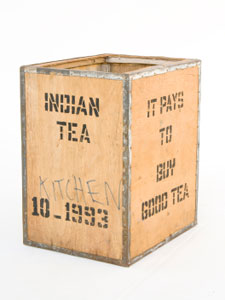Wholesaling Tea Pt 2: Sourcing, storing & blending


The US Wholesale Tea Business is a fascinating niche business characterized by an incestuous supply chain and an irrational focus on everything BUT product quality. In this series I'll attempt to unpack a few basic truths about the wholesale tea business that every entrepreneur should learn before either becoming a tea wholesaler or buying from a wholesaler.
In Part 1 I covered the industry at a high level. In this second installment I will focus on sourcing, storing and blending teas. will cover sales to independent retailers and specialty shops. Part 4 will focus on sales into Grocery and large retail channels. Part 5 will cover sales to food-service and hospitality operations.
For the last two years (and again in June) I've taught the Tea Purchasing class for the New Business Boot Camp at the World Tea Expo. In that class I get two hours to cover the subject and it feel like I'm only scratching the surface. Professional tea buyers and blenders spend YEARS learning their craft. In the next few minutes I'll do my best to at least give you a rough idea of what the world of tea buying and blending looks like.
First, we need to address the question of buying direct from source. A SMALL tea collection might contain 100 teas sourced from a dozen different suppliers in five countries. In order to keep shipping and import costs low, you need to be able to purchase and store large quantities from EACH source. The most efficient shipping method is a full 40 foot container of tea - roughly 8,000 Kilograms, or over 17,000 pounds. Your import costs for this shipment should be somewhere just under $1 per kilo. If you are a small wholesaler and are only able to purchase 25 Kg (55 lbs) from a single supplier, your import costs will likely be much closer to $20 per kilo. Good luck developing a competitive wholesale business with those numbers.
The question of direct sourcing is far more complex than this simple analysis of import costs, but let me say this: the BRANDING value of direct sourcing is HUGE. Even if it's ridiculously inefficient and you're only able to source one or two teas, being able to tell the story of your relationship with a single garden gives you tremendous credibility and the mystique of a "real" tea buyer. My general recommendation would be to source all but a handful of your teas from US wholesalers. Your costs will be much lower, the minimum quantities much more manageable, and you can rely on their ability to manage relationships and quality control across dozens of international partners.
As you choose your tea vendors in the US, I would encourage you to ask questions in the following categories:
| 1. Freshness | 6. Guarantees & Returns | ||
| 2. Supply Chain | 7. MSRP and Market Value | ||
| 3. Processing, Blending & Packaging | 8. Other Services | ||
| 4. Inventory Levels | 9. References | ||
| 5. Quality Controls |
There are three options for storing your teas. The first option is your home/garage/basement etc. A savvy buyer is going to ask where your warehouse is and not buy from you, but this isn't a terrible way to start IF you are able to sell your teas in the same packaging they arrive in. If you need to be able to open, blend and re-package tea you need to move on to option 2: create a Certified Food Handling Facility. Food handling is overseen by your local health department. The requirements are not onerous, but you will need dedicated, appropriate space for this enterprise. The third option is to partner with a wholesaler that will drop-ship for you. In this case your company is "virtual" and you never actually handle the product. When orders come in your partner will package the teas in your packaging and ship them in your box to your customer with your invoice. This is typically expensive, hard to control (quality and customer service), and not terribly profitable. That said, a number of tea companies have made their start this way.
Blending teas is at the same time incredibly easy and extremely difficult. Anyone can blend a tea, throw in a few inclusions (the proper word for dried flowers, fruits or pieces of candy designed to add color and sometimes flavor to a blend) and create their own blend. Adagio has been VERY successful letting customers create their own blends on our website. That said, creating a good, stable blend is not easy. Blending is both an art and a science. You need to understand how the blend will settle during storage and transport, how the flavors will mingle and change over time, which flavors will fade first, and what the customer experience will be using different types of water at different temperatures for different durations.
Quality flavored teas are made with liquid flavoring agents and the inclusions you see are primarily for aesthetic appeal. These liquid flavoring agents themselves are expensive, sometimes volatile, and differ dramatically in quality. They are also sold in large quantities appropriate for blending thousands of pounds of tea.
The best way to explain the complexity might be to compare it to the difference between cooking a good meal at home and being able to consistently deliver a top quality culinary experience in a restaurant over thousands of meals under less then perfect circumstances. It's not enough to be good. The customer has to choose your tea and be willing to pay for it!
To learn more about the art and science of blending teas, I would encourage you to attend the World Tea Expo and take one or more of the sessions on blending teas.
Adagio Teas
Twitter: @AdagioRetail
